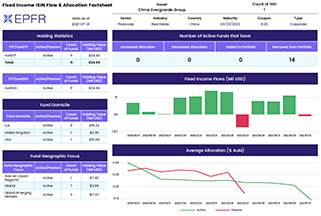Abstract:
This paper studies the asymmetric price impacts mutual fund and ETF flows have on individual stocks in demand-based asset pricing. Our analysis finds that the price impacts of their buying differ significantly from the impact of selling by these pooled investment structures.
At the extreme, selling by them reinforces a ”fire sale” dynamic whereby the price of an individual stock decouples from its fundamentals, thus being inelastic, while their buying is quite elastic.
Based on the modeling of idiosyncratic price impact estimator by lagged firm characteristics, we also show that:
- (a) Riskier stocks have larger price multipliers that increase the impacts of flow-related shocks
- (b) different fund groups produce different demand shocks, with those generated by ETFs and institutional mutual fund share classes markedly higher.
Authors:
- Sayad Baronyan, Scott Au – EPFR
- Yinghua Fan, Guanhao Feng – City University of Hong Kong



